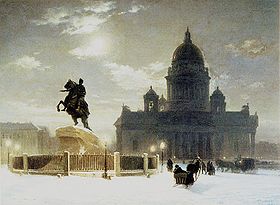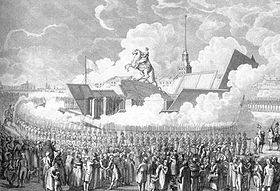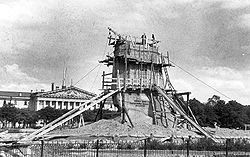- Bronze Horseman
-
This article is about the statue. For the poem by Aleksandr Pushkin, see The Bronze Horseman (poem). For the novel by Paullina Simons, see The Bronze Horseman (novel).
The Bronze Horseman (Russian: Медный всадник, literally "The Copper Horseman") is an equestrian statue of Peter the Great in Saint Petersburg, Russia. Commissioned by Catherine the Great, it was created by the French sculptor Étienne Maurice Falconet. It is also the name of a narrative poem written by Aleksandr Pushkin about the statue in 1833, widely considered to be one of the most significant works of Russian literature. The statue came to be known as the Bronze Horseman because of the great influence of the poem. The statue is now one of the symbols of Saint Petersburg, in much the same way that the Statue of Liberty is a symbol of New York City. Both of them were designed and built by French artists.
The statue's pedestal is the enormous Thunder Stone, claimed to be the largest stone ever moved by man (1,250 t).[1] The initial stone was about 2000 tonnes and was carved during its transit to the current site.
Contents
Statue
The equestrian statue of Peter the Great is situated in the Senate Square (formerly the Decembrists Square), in Saint Petersburg. Catherine the Great, a German princess who married into the Romanov line, was anxious to connect herself to Peter the Great to gain legitimacy in the eyes of the people.[2] She ordered its construction, and had it inscribed with the phrase Petro Primo Catharina Secunda MDCCLXXXII in Latin and Петру перьвому Екатерина вторая, лѣта 1782 in Russian, both meaning 'Catherine the Second to Peter the First, 1782', an expression of her admiration toward her predecessor and her view of her own place in the line of great Russian rulers. Having gained her position through a palace coup, Catherine had no legal claim to the throne and wanted to represent herself as Peter's rightful heir.
In correspondence with Catherine the Great, Denis Diderot suggested French sculptor Étienne Maurice Falconet, a friend of his, for the commission. The empress followed his advice, and Falconet arrived in Russia in 1766.[3]
In 1775 the casting of the statue began, supervised by caster Emelyan Khailov. At one point during the casting, the mould broke, releasing molten bronze that started several fires. All the workers ran except Khailov, who risked his life to salvage the casting.[3] After having to be remelted and recast, the statue was later finished. It took 12 years, from 1770 to 1782, to create the statue, including pedestal, horse and rider.
The tsar's face is the work of the young Marie-Anne Collot, then only 18 years old. She had accompanied Falconet as an apprentice on his trip to Russia in 1766. A student of Falconet and Jean-Baptiste Lemoyne, Collot was called Mademoiselle Victoire (Miss Victory) by Diderot. She modelled Peter the Great's face after his death mask and numerous portraits she found in Saint Petersburg. The right hand of the statue was modelled from a Roman bronze hand, found in 1771 in Voorburg, The Netherlands at the site of the ancient Roman town Forum Hadriani.
On August 9, 1782, fourteen years after excavation of the pedestal began, the finished statue was unveiled in a ceremony with thousands in attendance. Conspicuously absent was Falconet, as a misunderstanding between him and the empress turned into a larger conflict, and he was forced to leave Russia four years before the project was completed. Catherine largely forgot about him afterwards, and began to see the Bronze Horseman as her own oeuvre.[3]
The statue portrays Peter the Great sitting heroically on his horse, his outstretched arm pointing towards the River Neva in the west. The sculptor wished to capture the exact moment of his horse rearing at the edge of a dramatic cliff. His horse can be seen trampling a serpent, variously interpreted to represent treachery, evil or the enemies of Peter and his reforms.[4] The statue itself is about 6 m (20 feet) tall, while the pedestal is another 7 m (25 feet) tall, for a total of approximately 13 m (45 feet).[5]
Thunder Stone
 The Transportation of the Thunder-stone in the Presence of Catherine II; Engraving by I. F. Schley of the drawing by Yury Felten, 1770
The Transportation of the Thunder-stone in the Presence of Catherine II; Engraving by I. F. Schley of the drawing by Yury Felten, 1770
For the pedestal, an enormous boulder known as the Thunder Stone (Russian: Камень-Гром) was found at Lakhta, 6 km (3.7 mi) inland from the Gulf of Finland in 1768.[6] The Thunder Stone gained its name from a local legend that thunder split a piece off it. Falconet wanted to work on shaping the stone in its original location, but Catherine ordered it be moved before being cut.[7] As it was embedded half its depth and the area was marshy terrain, the Russians had to develop new methods to dig up and transport the colossal stone. Marinos Carburis (Μαρίνος Χαρμπούρης), a Greek from the Island of Kefallonia and serving as lieutenant-colonel in the Russian Army, offered to undertake the project. Carburis had studied engineering in Vienna and is considered to be the first Greek to hold a diploma in engineering.[8]
Carburis directed workmen to wait for winter, when the ground was frozen, and then had them drag the large stone over the frozen ground to the sea for shipment and transport to the city. He developed a metallic sledge that slid over bronze spheres about 13.5 cm (6 inches) in diameter, over a track. The process worked in a way similar to the later invention of ball bearings. Making the feat even more impressive was that the labour was done entirely by humans; no animals or machines were used in bringing the stone from the original site to the Senate Square.[8] After Carburis devised the method, it took 400 men nine months to move the stone, during which time master stonecutters continuously shaped the enormous granite monolith.[3] Catherine periodically visited the effort to oversee their progress. The larger capstans took 32 men at once to turn, this just barely moving the rock. Further complicating the issue was the availability of only 100 m of track, which had to be constantly disassembled and relaid.[8] Nevertheless, the workers made over 150 m of progress a day while on level ground. Upon arrival at the sea an enormous barge was constructed exclusively for the Thunder Stone. The vessel had to be supported on either side by additional two full-size warships.[8] After a short maritime voyage, the stone reached its destination in 1770, after nearly two years of work. A commemorative medal was issued for its arrival, with the legend "Close to Daring".[7]
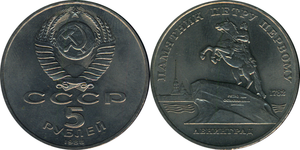 Commemorative coin released in the USSR in 1988 to commemorate the monument to Peter the Great
Commemorative coin released in the USSR in 1988 to commemorate the monument to Peter the Great
The "largest stone ever moved by man"
See also: List of largest monoliths in the worldThe Thunder Stone is sometimes claimed to be the "largest stone ever moved by man". This stone was large and heavy; it was effectively moved 6 km (3.7 mi) overland to the Gulf of Finland by manpower alone; no animals or machines were used. Transported by barge up the Neva River, it reached St. Petersburg. The entire effort is considered an historic engineering feat.
Due to the large size of the rock, the easiest way to measure its mass is to calculate it. According to the fall 1882 edition of La Nature, its dimensions before being cut were 7 × 14 × 9 m. Based on the density of granite, its mass was determined to be around 1500 tonnes.[8] Falconet had some of this cut away to make a wave-like shape, so the finished pedestal weighed slightly less. It is still the largest when compared to other large, sculpted stones:
- The unfinished obelisk in Aswan is estimated at 1200 tonnes. It was not ever moved, and was never detached from the rock from which it was being carved. 1200 tonnes is less than the initial calculated mass of the Thunder Stone.
- The Roman Stone of the Pregnant Woman in Baalbek is measured at around 20.5 m × 4–5.3 m × 4.2 m high, putting its mass at ca. 1,000 t.[9] It was removed from its quarry, but sits on an angle not far from the site of its extraction.[citation needed] It has less than the initial mass of the Thunder Stone.
- The Western Stone is estimated at 517 tonnes; it was moved as a single piece and was used as a foundation stone in the northern corner of the Western Wall in Jerusalem. The wall was constructed around 20 BC.
- The Great Broken Menhir of Locmariaquer, now in five pieces, was 20 m tall and likely weighed over 300 tonnes.
- The obelisk at the Basilica of St. John Lateran was broken into three pieces. After being transported to Rome, the pieces were put together and secured, as ordered by Pope Sixtus V. At 32 m tall, it probably weighs more than 350 tonnes.
- The Great Stele at Axum is estimated to have weighed over 500 tonnes. It was moved from its quarry, but is believed to have broken while being erected.
Siege of Leningrad
A 19th-century legend states that while the Bronze Horseman stands in the middle of Saint Petersburg, enemy forces would not be able to conquer the city. During the 900-day Siege of Leningrad by the invading Germans during the Second World War (Leningrad being the city's name from 1924–1991), the statue was not taken down, but covered with sandbags and a wooden shelter. The protection served so well that the Bronze Horseman survived the 900 days of bombing and artillery virtually untouched.[4] True to legend, Leningrad was never taken.
Poem
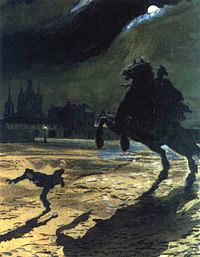 Alexandre Benois's illustration to the poem (1904)
Alexandre Benois's illustration to the poem (1904) Main article: The Bronze Horseman (poem)
Main article: The Bronze Horseman (poem)The Bronze Horseman is the title of a poem written by Aleksandr Pushkin in 1833, widely considered to be one of the most significant works of Russian literature. Due to the popularity of his work, the statue came to be called the "Bronze Horseman". A major theme of the poem is conflict between the needs of the state and the needs of the ordinary citizens.
In the poem, Pushkin describes the fates of the poor man Evgenii and his beloved Parasha during a severe flood of the Neva. Evgenii curses the statue, furious at Peter the Great for founding a city in such an unsuitable location and indirectly causing the death of his beloved. Coming to life, the horseman chases Evgenii through the city. The poem closes with the discovery of the young man's corpse in a ruined hut floating at the edge of the river.
In 1903 the artist Alexandre Benois published an edition of the poem with his illustrations, creating what was considered a masterwork of Art Nouveau.
The poem has inspired works in other genres: Reinhold Glière choreographed a ballet based on it, and Nikolai Myaskovsky's 10th Symphony (1926–7) was inspired by the poem.
References
- ^ Adam 1977, p. 42−45
- ^ "St. Petersburg in Architecture: The Bronze Horseman". University of Michigan Taubman College of Architecture + Urban Planning. 2003. Archived from the original on December 31, 2006. http://web.archive.org/web/20061231022939/http://www.tcaup.umich.edu/stpetersburg/bronzehorseman.html. Retrieved April 22, 2007.
- ^ a b c d "Bronze Horseman". Optima. 2007. http://www.saint-petersburg-hotels.com/medniyvsadnik.htm. Retrieved April 23, 2007.
- ^ a b "The Bronze Horseman". Saint-Petersburg.com. 2007. http://www.saint-petersburg.com/monuments/bronze-horseman.asp. Retrieved April 22, 2007.
- ^ "Saint Petersburg". TourArena. 2001. http://www.tourarena.ru/taeng.nsf/(vwSubSectionsForWeb)/1-1?OpenDocument. Retrieved April 22, 2007.
- ^ "Lakhta". Saint Petersburg Encyclopaedia. http://www.encspb.ru/en/article.php?kod=2804000245. Retrieved April 22, 2007.
- ^ a b "Thunder-Stone". Saint Petersburg Encyclopaedia. http://www.encspb.ru/en/article.php?kod=2804005242. Retrieved April 22, 2007.
- ^ a b c d e "(French) Transport du piédestal de la statue de Pierre le Grand". La Nature magazine, second semester 1882.. http://cnum.cnam.fr/CGI/fpage.cgi?4KY28.19/351/100/432/0/0. Retrieved April 22, 2007.
- ^ Ruprechtsberger 1999, p. 15
Notations
Statue
Pedestal
- (French) Adam, Jean-Pierre (1977), "À propos du trilithon de Baalbek: Le transport et la mise en oeuvre des mégalithes", Syria 54 (1/2): 31–63
- (French) Les Français à Saint-Pétersbourg, extrait du livre de N.Smirnova, ci-dessous.
- (French) Transport du piédestal de la statue de Pierre le Grand, in La Nature, 1882.
- (German) Ruprechtsberger, Erwin M. (1999), "Vom Steinbruch zum Jupitertempel von Heliopolis/Baalbek (Libanon)", Linzer Archäologische Forschungen 30: 7–56
Bibliography
- (French) Natalia Smirnova, Saint-Pétersbourg ou l'enlèvement d'Europe, éd. Olizane, Genève, 1996 ISBN 28-8086-191-8
- (French) Christiane Dellac, Marie-Anne Collot : Une sculptrice française à la cour de Catherine II, 1748-1821, L'Harmattan, (2005) ISBN 27-4758-833-5.
External links
Coordinates: 59°56′11″N 30°18′08″E / 59.9364°N 30.3022°E
Monuments of Saint Petersburg Alexander Column • Bronze Horseman • Hero-City Obelisk • Column of Glory • Cruiser Aurora • Peter I near St. Michael's Castle • Church of the Savior on Blood • Alexander Pushkin in Arts Square • Nikolai Gogol in Konushennaya Street • Chesme Column • Kagul Obelisk • Monument to Nicholas I • Mother Motherland • Moscow Triumphal Gate • Narva Triumphal Gate Categories:- Colossal statues
- Equestrian statues
- Outdoor sculptures in Russia
- Peter the Great
- Monuments in Saint Petersburg
Wikimedia Foundation. 2010.


